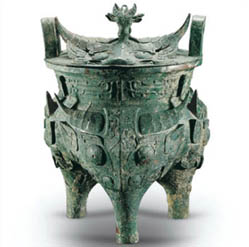
Beijing Capital Museum is located in the Confucius Temple at Guozijian Street, Andingmen, Beijing. It was prepared to build up in 1953. In encountered the setbacks in the construction duration and was officially opened to the outside world in 1981.
Except for Qufu Confucius Temple, Beijing Confucius Temple is the second largest one in China, which was initially built up on Da De the Sixth Year in Yuan Dynasty (the year 1302). It is the place for the emperors in Yuan, Ming and Qing Dynasties to sacrifice Confucius.
The Confucius Temple covers an area of 22,000 square meters with its construction acreage of more than 6,000 square meters. It has three courtyards that focused on Dacheng Palace. The two left and right Wu Palaces stands symmetrically and are divided by a middle axle line in the north and south direction. Xianshi Gate is now the entrance door of Beijing Capital Museum. Dacheng Gate, Dacheng Palace, Chongsheng Gate, and Chongsheng Memorial Temple are located northward in sequent.
The Confucius Temple preserved the world famous Jinshi (the title of successful candidate who passed through the highest imperial examination) nomination monument, the handwritings of Gongche (the title of successful candidate who passed through the imperial examination) and other celebrities' handwriting works. You can find the familiar names like Liu Yong, Ji Xiaolan and etc there. It also exhibits the vast Thirteen Inscriptions Monuments. They are excellent writing and engravings and brilliant articles. And it is the sole completed Thirteen Inscriptions Monuments in China. The ten stone drums imitated in Qian Long Period of Qing Dynasty and Han Yu's stone drums and song monument are also a series of treasure cultural relics that is preserved in good condition and has the clear handwriting on it. In the sacrifice main palace, it exhibits the sacrifice vessels and music instrument in accordance with its original arrangement. It revokes our memories to the solemn scene with the sound of bells and drums at past.
If the Confucius Temple were entitled as a glorious palace, then the cultural relics collected by Beijing Capital Museum is the rarity of this palace. There are lots of elaborate works in the palace such as the stoneware, bronze ware, ceramics, stone inscriptions, calligraphy and paintings, etc. The time duration of Beijing Historic Cultural Relic Exhibition can be traced back from hundreds thousand years to the year 1949. It elaborates the scenes of Beijing historic development in multiple profiles and levels through series of pictures, models and cultural relics.
Ever since the establishment of Beijing Capital Museum, it held hundreds exhibitions in different types concerning the history, cultural relics, revolutionary history and folk custom, etc. Moreover, it also held different types of exhibition in Japan, America, Singapore, Malaysia and other countries so that it carried forward Chinese culture and expanded international communication and received deep concern and warmly welcome by the foreign and domestic peoples.
Visiting Beijing Capital Museum, you may enjoy the elaborate works in the world, experiences artistic leisure, recognize the Chinese broad and deep culture and long history.
Address: No. 3, Guozijian Street, Dongcheng District, Beijing.
Telephone: 010-64012118
Entrance Ticket: 10 Yuan (US$1.2)
Opening time: 08:30-16:30, Closed on Monday.
Bus route: Bus Nos. 13, 116, 113 or by underground railway, and get off at the Yong Hegong station; bus 104, 108 and get off at Andingmen stop.
(China.org.cn)
|

